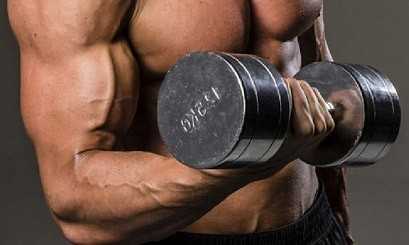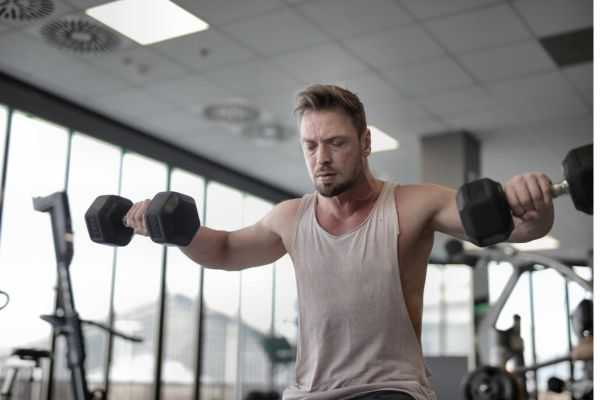where Drop sets, also called as Descending sets, is a technique in weight training, you perform a set number of reps with a given weight, to concentric failure; quickly reduce the weight, lift again to concentric failure, and continue so on.

The amount of weight reduction generally ranges from 10-30% of the initial load, in every drop. Though this is not a strict percentage as there are no guidelines to employ drop sets.
You will notice that in each subsequent drop, you won’t be able to perform a lot of reps, despite of the fact that weight is reduced. This is because of the cumulative fatigue during the movement.
Muscular failure can be operationally defined as “the point during a resistance exercise set when the muscles can no longer produce sufficient force to control a given load”. However, muscles are not completely fatigued at the point of concentric muscular failure as they are still capable of producing force at lower loads. Therefore, drop sets, may be an effective strategy to more fully fatigue the musculature and, in turn, enhance muscular adaptations.
Drop sets are great technique to save time, as it allows continuous high muscle fiber recruitment even during lower loads, which in normal cases will need much more reps, at that particular weight.
Bodybuilders and some fitness enthusiasts use this type of training to increase muscle hypertrophy, but it may also result in gains in local muscular endurance. Although not recommended for beginners, drop sets can be used by seasoned strength athletes and weightlifters to overcome training plateaus.
Also, drop sets performed properly, are extremely fatiguing. They shouldn’t be used day in day out in every workout. Once a week is more than enough for a particular muscle group muscle group.
The best part about drop-sets is that they engage the entire spectrum of muscle fibers. Starting from fast twitch muscle fibers in the initial sets, to slow twitch muscle fibers in the last sets. Because of this, the amount of pump which the person feels post a drop set is phenomenal.
Drop sets can be performed on both free weights and machines, either by shedding the plates or by adjusting the pin along the weight stack in a machine. Someone using the dumbbell will also follow the same pattern, but will be using lighter dumbbells in every subsequent set.
For e.g. if we are doing a dumbbell bench press. The aim is to first reach the weight to a relatively heavier one. Let’s say, we do first set with 25kg for 12 reps, 35kg for 10, and 40kg for 8 reps. Now, your drop set will start from the final and heaviest weight i.e. 40kg.
During the drop set, you will perform 8 reps or more with 40kg, which is till concentric failure. Now, you drop the weight by 10kg to 30kg, and push as many reps as possible, till the point of concentric failure. And last you drop the weight by 5-10kg more, and again push out maximum reps till failure.
Between each reduction or drop in weight, there is no rest. You have to continuously perform subsequent sets in the drop sets, till the last set.
Also, because the you are pushing every set in a drop-set to level of failure, the burn is extreme. Therefore, you must have a spotter, whenever you are using free weights in your drop set. They will help you in reducing the weights, without you getting up from your position, and also help spot any imbalance in weight, during failure.
Make sure, you are performing the drop sets at the end of the workout, as the pump & cumulative fatigue is extremely high to put in maximal effort in any subsequent exercise for that body part.

Are drop sets better than traditional sets? Let’s see what the studies have to say:
- A study, determined the effect of drop sets on muscle strength and endurance of trunk extensors among 30 trained men. Participants were assigned into two groups; experimental group that underwent drop sets and control group submitted to high load resistance training.
The results indicated that participants in drop-set group attained statistically significantly greater gains in muscle strength and muscular endurance of trunk extensors, compared to high load training.
- A study, investigated the effects of two strength training protocols, equated in volume, on the elbow flexor muscle thickness (MT) in women. Twenty-seven women were divided in three experimental groups: a drop-set (DS), a traditional (TR), and a control group (CG). The CG maintained regular strength training without perform any upper body exercises.
The participants performed a dumbbell biceps curl for two days per week for 12 weeks 4 sets of 3 blocks of 10 repetitions at 75%, 55%, and 35% of their 1 Repetition Maximum (RM) for the DS group, and 8 sets of 11 repetitions at 75% of the 1RM for the TR protocol.
There was a significant increase in all muscle thickness for the training groups. In addition, significantly higher values of muscle thickness were found in the training groups compared to the control group. No significant differences were found between training the groups for MT. Thus, the two strength training protocols (DS and TR), equated in volume, are equally effective in increasing the muscle thickness of elbow flexors muscles in women.
- A study, investigated the effects of 2 different resistance training (RT) protocols on muscle hypertrophy and strength. The first group performed a single drop set and the second group performed 3 sets of conventional RT (normal set).
The results showed significant increases of triceps CSA in both groups, but the increase rate of the drop set group was markedly larger than that of the normal set group. Metabolic and perceived stress markers were significantly higher in the drop set group than in the normal set group, which might lead to superior anabolic responses compared to normal set training.
- A study, investigated the effects of a single high-load (80% of one repetition maximum [1RM]) set with additional drop sets descending to a low-load (30% 1RM) without recovery intervals on muscle strength, endurance, and size in untrained young men. Nine untrained young men performed dumbbell curls to concentric failure 2-3 days per week for 8 weeks.
The study found that, a drop set resistance training program can simultaneously increase muscle size, strength, and endurance in untrained young men, even with lower training time compared to typical resistance exercise protocols using only high- or low-loads.

- A study, compared the effects of drop set resistance training (RT) versus traditional RT on markers of maximal muscle strength and regional hypertrophy of the quadriceps femoris, in 16 men, who performed unilateral seated leg extensions for eight weeks.
Study found that, drop sets elicited superior hypertrophy of the rectus femoris muscle, whereas the hypertrophy of the vastus lateralis was similar between conditions. In addition, drop set did not appear to enhance strength-related adaptations compared to tradition training.
- A study, compared the effects of pyramid and drop-set systems with traditional resistance training. Study found that, Pyramid and Drop-set systems do not promote greater strength gains, muscle hypertrophy and changes in muscle architecture compared with resistance training traditionally performed with constant intensities and volumes.
- A study, considered 36 male and female participants divided into 3 groups: breakdown set (drop set), heavy-load breakdown, and traditional, performing full-body resistance training programs 2 times per week for 12 weeks.
No significant differences were identified for change in absolute muscular endurance or for body composition, among the groups. Thus, the use of advanced training techniques stimulates no greater muscular adaptations when compared with performing more simplified resistance training protocols to momentary muscular failure.
- A meta-analysis study, assessed the effects of drop set training vs. traditional training on measures of muscle strength and hypertrophy. the study showed that, overall, drop sets are likely to produce similar effects on muscular strength and hypertrophy as traditional training.



